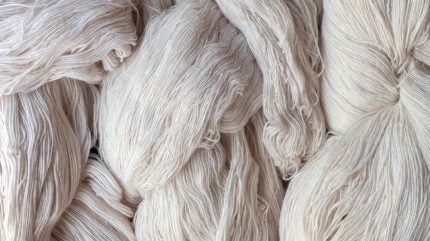
According to the research, washing synthetic fabrics can release millions of microfibres, posing a significant threat to the environment. Microfibres are particularly problematic for marine life and the fibres can take hundreds of years to degrade.
The objective of the research was to shed slight on the impact of manufacturing choices on microfibre release in textiles as they are washed.
To conduct the study, Alice Hazlehurst, a doctoral researcher at University of Leeds’ School of Design, led a research team that used a washing simulator, called a gyrowash, to test various densities of yarns in unknitted hanks and knitted forms.
The researchers compared how much microfibre each sample released when washed.
Key findings on microfibre release:
- Unknitted polyester released more microfibre than unknitted cotton, but similar amounts were released when polyester was knitted. This suggests that polyester suffered less damage than cotton during the knitting process.
- Microfibre release in tightly knitted fabrics during laundering was reduced, but manufacturers should also consider “fibre fly” – the visible fluff that comes off fabrics as they are knitted in factories, which is higher when garments are tightly knitted.
- Vortext-sun yarns (where fibres are twisted using jets of air in a vortex) had a lower microfibre release than ring-spun yarns (where fibres are twisted in a metal ring). Ring-spun yarns tend to be ‘hairier’ than vortex-spun yarns, which has been shown to increase microfibre release in washing.
The researchers concluded that changes to the fibre composition and the yarn spinning system would have the greatest influence in terms of reducing microfibre release.
However, the researchers added, these details are not currently included in product specifications, which makes it more difficult for brands to make informed choices about which garments will release more or less microfibre.
University of Leeds’ Hazlehurst believes that their findings show the entire process of textile production, down to the way yarn is spun, is important in the effort to limit microfibre release.
Hazlehurst said: “Our findings show that the entire process of textile production, down to the way yarn is spun, is important in the effort to limit microfibre release. Manufacturers should contain these details in specifications of yarn spinning, as well as the fibre type, to help clothing designers make more informed choices.”
Dr Mark Taylor, research fellow at Leeds’ school of design, added: “We know cotton produces more microfibre than polyester and people assume that cellulose (from cotton) is less worrying than microplastic because it’s natural. But the truth is that we don’t have enough information about the impacts of these fibres on humans, aside from knowing they can take hundreds of years to biodegrade and can have a negative impact on marine life.”
The academics are calling for more research into the effects of microfibre release on the environment and human health so measures can be targeted towards reducing harm.
In August 2023, another research paper ‘Impact of sewing on microfiber release from polyester fabric during laundry’ revealed that laser and ultrasonic cutting methods can reduce microfibre release from garments by up to 20 times compared to using conventional scissor-cut edges.



